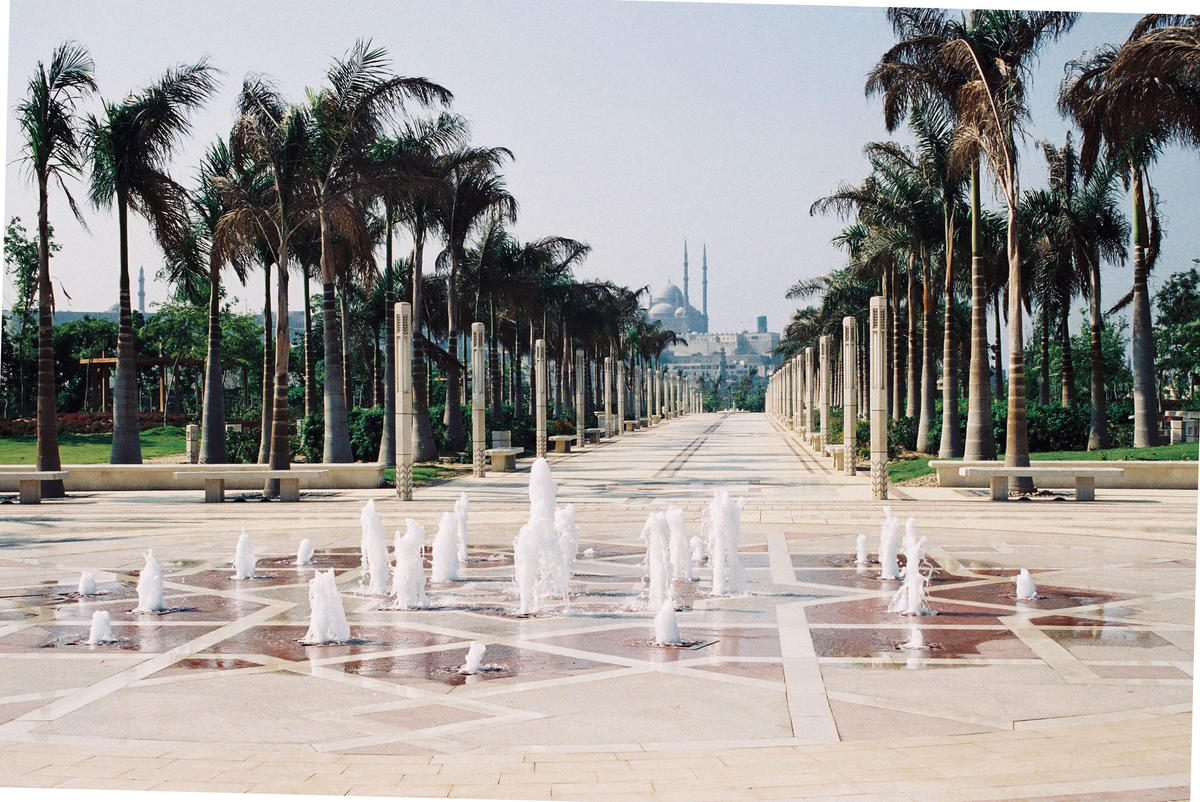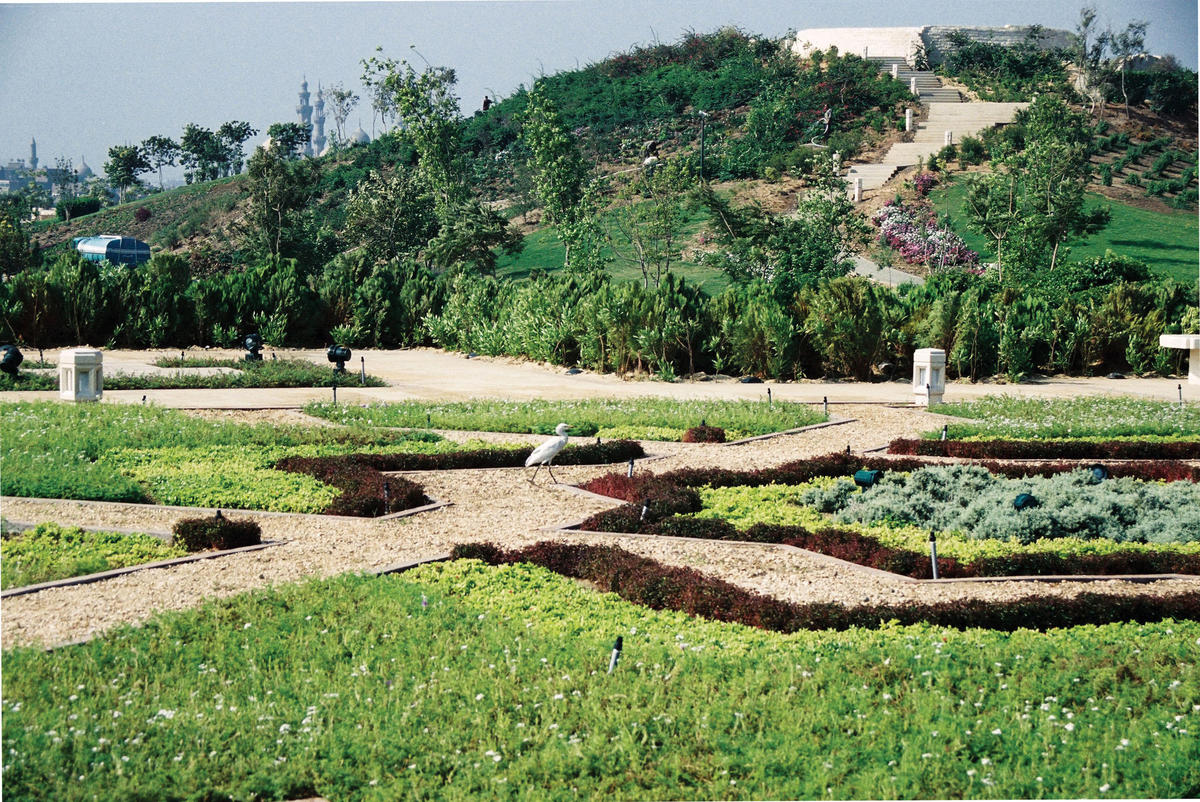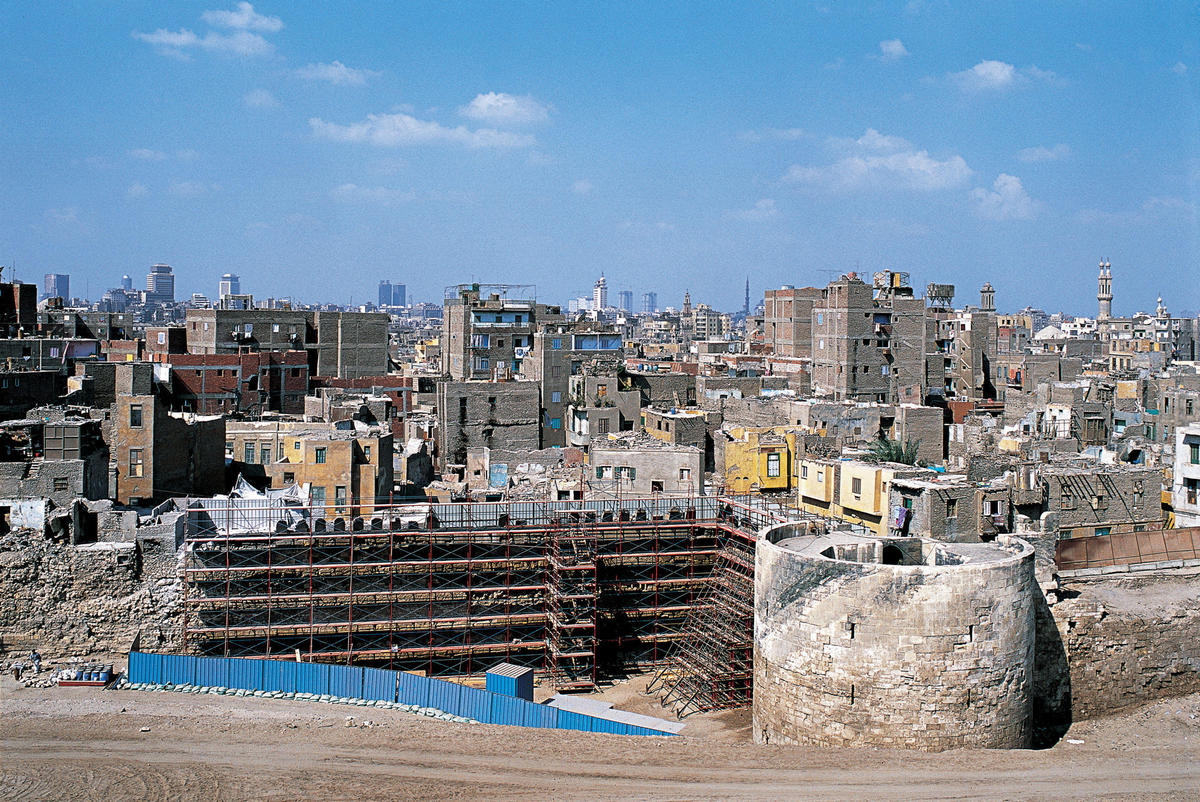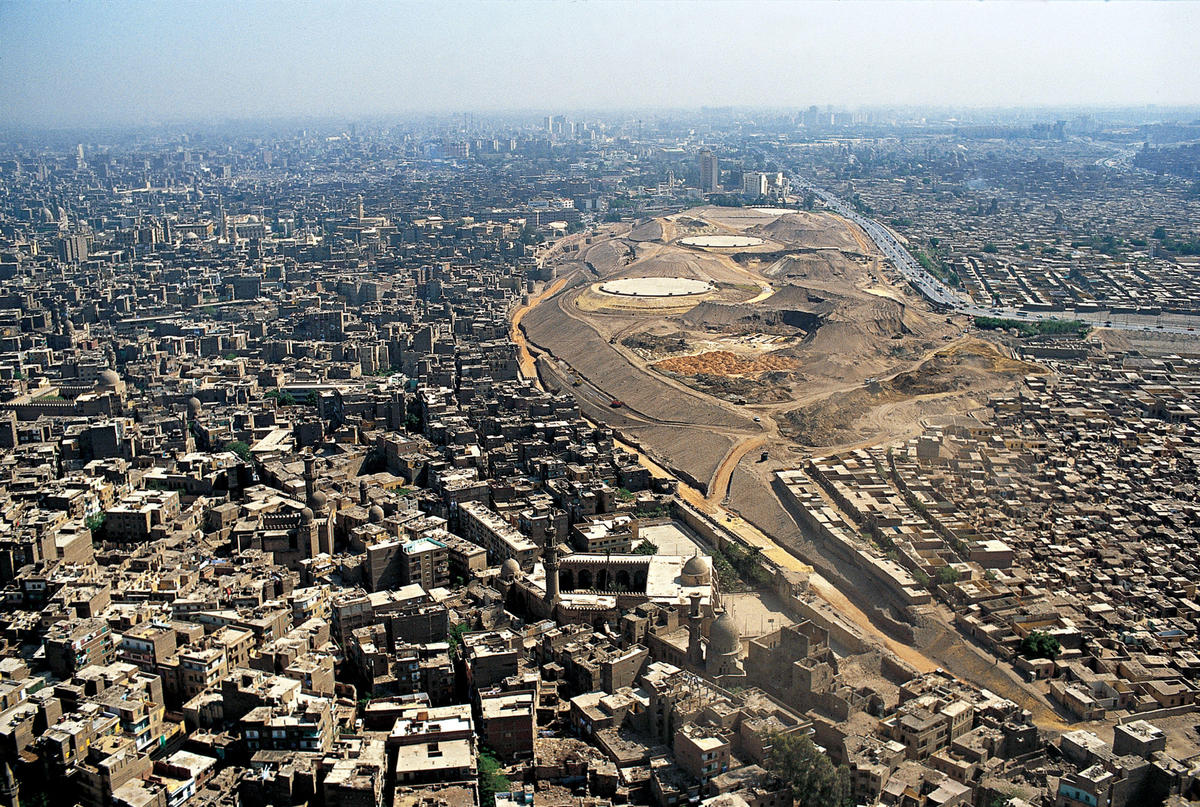
Green space comes at a premium in Cairo. While there are many parks in Cairo, these tend to be relatively small and neighborhood-centered affairs. There are no Central Parks here that help define the center of the city, no Hyde Parks or Jardins du Luxembourg that provide a central lung to an asphyxiated metropolis.
The sad fact is that like many other things in Egyptian capital, access to large green areas where one is free to roam as one wishes is limited to a small elite. Following the example of the Gezirah Club in the middle of the central island of Zamalek — which before the Free Officers’ coup of 1952 was the key gathering point of the city’s foreign dignitaries, and to a lesser extent, native aristocracy — a series of vast clubs now dot the city’s more affluent neighborhoods. These attract different clientele — military officers, the management of large state-owned companies, the new middle class that made its riches either in the Gulf or through the comprador capitalism of the economic liberalization begun in the 1970s — but provide an important social service for status-conscious Egyptians. These clubs, along with private schools and hair salons, offer a place where Cairenes may socialize safe in the knowledge that they will be among their peers, and perhaps most importantly of all, that their sons and daughters will grow up and play only with other children from “good families.”
Membership in these clubs is not only very expensive, but also hereditary, ensuring that a family that is down on its luck but of “good stock” can continue to frequent them. This is an arrangement that ensures, among other things, that pedigree and wealth can mix easily, reinforcing one another against the rabble outside these hallowed lawns, more often than not through marriage. This spatial segregation — the rationing of green space for the well-heeled — may have now come to a partial end with the creation of the Al Azhar Park, a 30 hectare project that has created a luxuriously green oasis in the middle of a city of stone and sand. Entering the Al Azhar Park for the first time is a powerful experience for a resident of Cairo, whose typical foliage consists of dust-covered trees. Entering the park on a chilly Friday morning, when many Cairenes are either still asleep or preparing for prayer, was an almost overwhelming emotional experience for this writer. Perched atop a series of hills salvaged from rubbish dumps and a storage area for a government-owned construction company (and previously stables for the Egyptian cavalry), the park is a rich green speckled with flowers. (The horticultural aspect of the park is one of its greatest feats; as it is built on multiple layers of the city’s garbage, thorough testing had to be done which flowers and trees would thrive on its nutrient-poor, alkaline soil. In the end, a 20 hectare nursery was created for the park outside the city to grow its plant stock and test several thousands of breeds for suitability.) Its lawns are perfectly manicured, its flowerbeds a mixture of French rigidity and English abandon, while marble and other rich materials adorn its structures. Most impressively, the skies — usually thick with smog — seem to part over the area, showering it with warm sunlight. Set against a vista of dozens of minarets, the impressive Cairo Citadel complex, an escarpment adorned with military radars, and perhaps most of all the rag-tag third world architecture of the city (which could be any large city of what development experts now call the global south) the impression it gives is, as one writer put effusively put it, of paradise.
There is something Augustinian about the Al Azhar Park in that it evokes a city of God surrounded by a seemingly endless city of Man. It is an image of perfection by contrast, but with a cruel twist: it is all too evident that the park is an exception to a rule of chaos and pollution that is Cairo; next to a discombobulating, hopelessly flawed but warm and often embracing city it seems achingly beautiful but cold and austere.
The Al Azhar Park is the result of twenty years of work by the Aga Khan Trust for Culture’s Historic Cities Support Program, an initiative that seeks to address conservation issues in the cities of the Islamic world. The Aga Khan Trust for Culture, perhaps best known for its Aga Khan Award for Architecture, is the brainchild of the current Aga Khan — the title given to the spiritual leader of Ismailis, an offshoot of Shia Islam with its roots in Persia and the Indian subcontinent as well as the Arab world.
The Aga Khan launched the Al Azhar Park initiative in 1984 during a conference on the future of Cairo, after noting that the city lacked any major public green space. But its implementation was delayed until the 1990s, after the area chosen for it along the medieval city walls was emptied and the construction of several water reservoirs by the US Agency for International Development was completed. In the twenty years it took to take the park from concept to its current status, the project also grew to include other elements, including the restoration of the wall bordering it and of several important listed buildings in the popular neighborhood of Darb Al Ahmar on the other side of that wall, which contains one of the highest density of Islamic sites in the city. In turn, the restoration project led to the creation of a social development program that included restoring houses adjacent to the wall and providing an opportunity for the local community to get involved in the overall plan.
The Al Azhar Park project — seen as a whole that includes social and conservation elements as well as the creation of park — can be commended for having taken a holistic approach that is sensitive to the needs of the local population and receptive to their input. Indeed, over the past decade, the project has been one of the main drivers of change in the neighborhood. Not so long ago, Darb Al Ahmar was refuge to some of Cairo’s biggest drug lords, who held complete sway over the neighborhood and were left to their own devices — along with ordinary residents — by the police. They held a daily ceremony that took place in a back alley not far from the now restored medieval wall, wherein these drug lords would gather around large tables covered with huge stacks of bango, the local rather mind-numbing variant of marijuana, and distribute it among dealers and addicts that would come from across the city. While drugs have not disappeared from Darb Al Ahmar — indeed in many poor districts of Cairo heroin has begun to replace bango has the opiate of choice — Darb Al Ahmar’s drug lords were forced to retreat in the 1990s, when a police force no longer distracted by Egypt’s long war against Muslim fundamentalists began to take its role more seriously. It is thought that the presence of the Trust in the area may have convinced local authorities to police the neighborhood again.

The Trust’s employees established one of their main offices in one of the neighborhood’s alleyways, eventually restoring a beautiful late nineteenth century mansion into what has become today a community center and children’s library as well as office space. The Trust’s employees are partly foreigners and partly recruited among Egyptians. The very presence of the project, therefore, created a dynamic of social mixity that is relatively rare in contemporary Cairo. Conceivable, Darb Al Ahmar became important again to the police and others because there were respectable people there to point out its decay.
Cairo is really multiple cities built one after another, each a new incarnation of the city beginning as a grandiose new project and often finishing in abandon as developers and the city’s status-conscious denizens rush to the latest new neighborhood. Although the historic heart of the city has always been on the eastern bank of the Nile, since the 1960s there has been a vast expansion westward — an encroachment on scarce agricultural land (only three percent of the country is arable) driven by the manifest destiny of demography.
Over the years, these new areas drew affluent inhabitants from the overflowing old quarters and new immigrants from the provinces. This left many of Cairo’s historic neighborhoods in slow decay, only to become overcrowded slums whose confined, labyrinthine structure offended the lock-step sensibility of the modernist 1960s. Darb Al Ahmar, one of the richest areas of the capital in terms of medieval Islamic architecture, is one of those areas of Cairo that has been left behind.
Darb Al Ahmar borders sites that are central to Cairo’s historic identity, the such as the Khan Al Khalili, a merchant’s quarter whose current tourist-trap appearance hides a long history as a hub of trade and craftsmanship for several centuries, or Al Azhar university, perhaps the most influential center of Sunni Islam in the world. It is a warren of mosques, madrasas, regal houses and awqaf — religious endowments left behind by wealthy patrons for posterity — all huddled together, almost atop one another, competing for attention from the odd adventurous tourist that strays from the central attractions of Fatimid Cairo.
Originally, Darb Al Ahmar was the first extension of Al Qahira, the city founded in 969AD after the Fatimid conquest of Egypt to house the new elite. Al Qahira — literally “the victorious,” and the name from which we derive Cairo — had been built as a fortress city. Most Egyptians did not live there, but rather in an earlier incarnation of the Egyptian capital at Misr-Fustat. Centers of power, however, have a tendency to draw visitors, merchants and supplicants, and it became clear before too long that Al Qahira would grow beyond its walls. Darb Al Ahmar became the first of a long series of expansions after an extension of city walls and the immigration of Misr-Fustat’s inhabitants after a drought in the eleventh century. Its boundaries were defined by the pre-existing walls of Fatimid Cairo on the one side, and the new wall linking Fatimid Cairo to Saladin’s citadel, which by then had usurped Al Qahira as a center of power. Darb Al Ahmar, in the middle, became an area for the nouveaux riches not unlike the neighborhoods that emerged on the west bank of the Nile in the 1970s.
Despite this illustrious history, today’s Darb Al Ahmar exemplifies the abandonment of former centers of Cairo for new areas. Islamic Cairo as a whole — that is including various neighborhoods such as Darb Al Ahmar, Fatimid Cairo, the Citadel area and others — was abandoned in the late nineteenth century by the Khedives, the descendants of Muhammad Ali, who moved the seat of government to a new Italianate palace in Abdin and decided to build a new nervous center for Cairo around what is currently known as downtown. The brief apogee of this area, a mishmash of art nouveau, art deco and early modernist buildings that once earned the capital the moniker of “Paris on the Nile,” shifted the political and economic center of the city back along the eastern shore of the Nile, creating wide avenues and imposing, spacious buildings rather than the narrow alleys and the small but ornate Islamic architecture of the old city. Islamic Cairo may have been the favorite setting of the doyen of twentieth century Egyptian literature, the Nobel Laureate Naguib Mahfouz, but that may have only been because it represented an Egyptian authenticity that the westernized downtown area — with its strictly class and at times nationality-segregated clubs and cafes and its large expatriate population — could not possess.

On one trip to the park, I brought along Vincent Battista, a French anthropologist who specializes in gardens and oases in the Middle East. Battista, with the keen eye of the expert, pointed to the trees that line the entrance and the main artery of the park. They were, he said, Cuban royal palms. As their name suggests, Cuban royal palms are not indigenous to Egypt, although they are often preferred to the local variety because their smooth, graded bark evoke luxury. “Cuban palms are used to denote class and wealth,” Battista told me, explaining they are often used in the landscaping of sites that need to convey a sense of exclusivity.
The same sense of the grandiose extends to the park’s main attraction, a central artery that descends from the luxurious restaurant atop its highest hill (which during the holy month of Ramadan was booked full every night for iftar (breaking of the fast) by corporations and foreign embassies.) The Fatimid archways and chic understatement of the restaurant morphs into a 250 meter promenade facing the Citadel complex, with a central canal taking water on a gentle downhill slope to a fountain at the bottom. The effect is perhaps more Persian that Arab, with a touch of Versailles thrown in for good measure.
The park’s other main features — a gazebo behind the restaurant, an artificial lake and the large café that borders it — have also been done in keeping with carefully groomed rendering of Islamic architecture — although it is an ad lib on general Islamic themes more than a precise period imitation. It is not surprising that some of the landscapists and architects who worked on the park — including a local company, Sites International — normally work on the five-star resorts that have proliferated along the coasts of Sinai and the Red Sea. While certainly beautiful and tasteful, their creations have a manufactured sense to them, particularly when surrounded with genuine period architecture ennobled — and decayed — by the passage of time. There is a wonderful irony in the friction between the buildings of the Al Azhar Park and those in the bordering neighborhoods. While the original buildings have often decayed, left only to attract the odd tourist or Islamic history buff, the derivative buildings of the Al Azhar Park are attracting the cream of Cairene society. Historic architecture languishes among shoddily built concrete buildings, most of them unfinished to accommodate the whim of another floor (even if at the expense of structural stability) while the cultural elite are content to admire the vista from the safe distance of their VIP parties.
There is therefore an awkward duality to the Al Azhar Park. On the one hand, it was envisaged as the city’s park (even if it is in a location that is not easily accessible by most Cairenes) and one of the project’s ambition was to tackle the lack of large-scale green space in Cairo. On the other hand, by virtue of its location and the aspects of the project that have focused on restoring some of Darb Al Ahmar’s buildings and the wall separating it from the park, it also has a local dimension. This duality is at its most evident when it comes to the pricing policy to enter the park. The entry price for adult Egyptians has been set at six Egyptian pounds. This means that a family of four or five would be asked to pay up to twenty pounds, which is an exorbitant sum when one considers that the Cairo Zoo, the other main open space in the city, only costs a quarter of a pound. And yet, locals from Darb Al Ahmar can benefit from a reduced pricing of around two Egyptian pounds. These sums — six Egyptian pounds are worth a little less than a dollar — may seem paltry but by western standards the majority of Egyptians have extremely low salaries, with civil servants often making around three hundred pounds per month (less than fifty dollars).
While officials involved in the project said that the pricing scheme is under revision, they are clearly of two minds about it. Seif Rashidi, an Egyptian urban planner who has worked on the park’s Darb Al Ahmar project since the late 1990s, told me that one of the ideas for the park was that it should be a place where all social classes could mix but there was also a concern that entry should not be free to help foster the idea that the park was a valuable site worth preserving. And while the Hilltop Restaurant is clearly dedicated to an elite clientele, the lakeside café is not exactly cheap either, particularly by the standards of nearby coffee shops. Likewise, it does not seem that the park’s authorities would allow peddlers to sell less expensive food and drinks, a move that would also foster employment in the area.
“It’s difficult to work with people from both extremes,” Rashidi said. “On the one hand people from areas like Darb Al Ahmar need to feel comfortable, and on the other people from the elite need to feel that it is elite enough. It’s a difficult balance.”
So far, the Trust says the park has attracted 1700 people per day during weekdays and more on weekends — nowhere near the number the park could accommodate. But one gets the sense that the park’s creators are protective after all the effort made to create such a magnificent site. Egyptians tend to have a low opinion of their ability to maintain order; the chaotic quality of life in their capital has in particular convinced the polished elite that the masses are undeserving of green areas. The few public areas on the recently created pedestrian zone along the Nile’s corniche are, for instance, ruthlessly policed and it is not infrequent to see people (for whatever reason) turned away from its gates. There is a feeling that the same phenomenon could take place in the Al Azhar Park, even if its patrons have endorsed the idea that at the very least the residents of Darb Al Ahmar should have cheap and convenient access to it.
But perhaps it is too early to tell. One wonders whether the park will simply be yet another semi-public space, like the new neighborhoods’ gilded shopping malls, that are in theory open to all but in practice are prohibitive to poor Egyptians because of their cost or, simply, the overwhelming feeling that they do not belong. There are also concerns that within a few years, stewardship of the park may be handed over to an underfunded Cairo governorate which will fail to fully fund the maintenance of the luxurious garden. The act of creating the park in of itself was a broad pledge of optimism. Let us hope that it will inspire its benefactors to preserve it and work to reduce its Olympian, otherworldly qualities and weave it into the fabric of the city.
